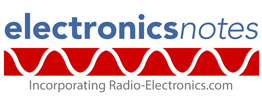Home » Component data » MOSFET data » this page
BSS169 Small Signal MOSFET
Data for the BSS169 small signal MOSFET including electrical parameters, maximum current and voltage, pin connections, package type and many other datasheet details.
The BSS169 is an N-Channel depletion mode MOSFET and as such it is normally ON when the gate-source voltage (VGS) is 0V. A negative VGS is required to turn it OFF.
The device has a low gate charge level and this contributes to relatively fast switching speeds.
The BSS169 is a small signal device designed for lower current applications. It has a low gate threshold voltage (VGS(th)) which is typically between -1.8V and -2.9V, meaning a small negative voltage is sufficient to turn it off.
Key details and performance parameters for the BSS169 MOSFET.
| BSS169 MOSFET datasheet parameters & data |
|
|---|---|
| Parameters | Details |
| Brief description | Small signal 100V MOSFET |
| Package type | SOT23 |
| Operational mode | Depletion |
| Channel type | N-channel |
| Drain to Source voltage VDS | 100V |
| Drain to Source breakdown voltage V(BR)DSS) | 100V min |
| Gate to source voltage VGS | ±20V |
| Maximum drain current continuous ID | 170mA at 25°C, 140mA at 70°C |
| Maximum drain current pulsed ID | 680mA @ 25°C |
| Gate threshold voltage VGS(th) | -2.9V min, -2.2V typ, -1.8V max ** |
| Static drain source ON resistance RDS(ON) | 5.3Ω typ, 12Ω max at VGS = 0V & ID = 0.05A 2.9Ω typ, at VGS = 10V & ID = 0.19A |
| Forward transconductance gFS | 0.20 typ |
| Input capacitance | 51pF typ, 68pF max |
| Output capacitance | 9pF typand 13pF max |
| Reverse transfer capacitance | 4pF typ, 7pF maxpF |
| TJ °C | 150 |
| PTOT | 0.36W |
| Primary manufacturer | Infineon |
Outlines & pinout:
Explanation of MOSFET parameters
| Parameter | Explanation |
|---|---|
| Operational mode | This details whether the FET is an enhancement or depletion mode |
| Channel type | The channel of the MOSFET can either be an N-type channel where electrons are the majority carriers or P-type where holes are the majority current carrier. |
| Drain to Source voltage VDSS | This is the maximum voltage that can be sustained between the drain and source |
| Gate to source voltage VGSS | This is the maximum voltage that can be sustained between the drain and the gate. |
| Maximum drain current continuous ID | This is the maximum current that can be carried byt he device. Sometimes there may be a differentiation between the continuous and pulsed or peak values |
| Parameter | Explanation |
|---|---|
| Zero gate voltage drain current IDSS | This is the current carried by the device when the gate voltage is zero. The test conditions are normally stated for this. |
| Gate threshold voltage VGS(th) | This is the minimum gate-to-source voltage, VGS required to create a conductive channel between the source and drain terminals |
| Static drain source ON resistance RDS(ON) | This is the resistance of the device when turned on. The test conditions of voltage and current are normally given for this. |
| Drain source ON voltage VDS(ON) | This is the voltage across the device when it is turned on. Again the test conditions are given. |
| Forward transconductance gFS | Forward transconductance also given the letters gm is defined as the change in drain current (ΔID) for a small change in the gate-source voltage ΔVGS, with the drain-source voltage, VDS held constant. |
These are the main MOSFET parameters that have been included in our list. There are others, but these are the main ones and they help quantify the main elements of the performance.
Please note, that the data given is the best estimate we can give within a tabulated summary of this nature. Parameters also vary between manufacturers. Electronics Notes cannot accept any responsibility for errors, inaccuracies, etc, although we do endevaour to ensure the data is as accurate as possible.
Notes and supplementary information
• Availability & sources
The BSS169 is available from a number of stockists and electronic component distributors many of which are given in the table below.
BSS169 Component Distributor, Stock and Pricing
• ** VGS(th) bands
The BSS139 has suffix letters added to the part number to distinguish the various threshold voltage bands for the device.
| |
||
|---|---|---|
| Device suffix | Minimum (V) | Maximum (V>) | J | -2 | -1.80 | K | -2.15 | -1.95 | L | -2.3 | -2.1 | M | -2.45 | -2.25 | N | -2.6 | -2.4 |
• Further details
The BSS169 find many uses in a number of different circuit design areas. These can include:
Current Regulation: Due to its depletion mode operation (normally ON), the BSS169 can be configured as a simple current regulator using just a resistor in series. The drain current is relatively independent of the drain-source voltage for a given gate voltage.
Linear Voltage Regulators (LDOs): It can serve as the pass transistor in linear voltage regulators, especially in applications requiring a specific current source behavior.
High-Side Switching: Its N-channel nature allows for high-side switching in certain configurations, controlling the positive supply to a load.
Power Supply Startup Circuits: Depletion mode MOSFETs like the BSS169 are often used in the startup circuitry of switch-mode power supplies (SMPS) to provide initial current to the control IC before the auxiliary winding takes over.
Over-Voltage Protection: It can be implemented in over-voltage protection circuits to crowbar the supply in case of a fault.
In-Rush Current Limiting: Used to limit the initial surge of current when a circuit is powered on.
Off-Line Voltage Reference: Can be part of simple off-line voltage reference circuits.
Level Shifting: While its voltage rating isn't as high as the BSS127, it can still be used for level shifting in lower voltage applications.
 Written by Ian Poole .
Written by Ian Poole .
Experienced electronics engineer and author.
Return to Component Data menu . . .





